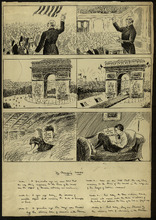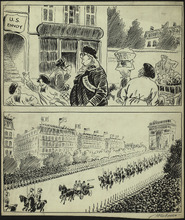12mo (17 x 12.3 cm, 6.75 x 4.875"). [1] f.A "Peaceable Kingdom" leaf from a small Bible: Paris was the center of Bible production in the 13th century, with the text having been standardized there, and the University attracting scholars who wished to have just such a small Bible as this leaf came from—a new thing in the 13th century. The text here is Isaiah 61:3-66:10, containing a prophecy of the restoration of Jerusalem, including the well-known Isaiah 65:25: "The wolf and the lamb shall feed together, and the lion shall eat straw like the bullock: and dust shall be the serpents meat. They shall not hurt or destroy in all my holy mountain, saith the Lord."(KJV)nnThis leaf is of very fine paper-thin vellum. The text is in two columns per page of 53 lines, faintly ruled in lead, the top line written below the top rule; it is written in black ink in an extremely small and compact Gothic script of the style typical of Bibles and other scholarly manuscripts of the 13th century. The running headers are in red and blue ink, the numbers heading each chapter are likewise in red and blue, and the 5 two-to-three-line initials (3 on the recto, and 2 on the verso) beginning each chapter are in red or blue, the Q's with long descenders, and all with elaborate long tracery in the contrasting color. A few instructions to the rubricator are to be found in the gutters.nnParchment with slight cockling. Some letters rubbed, affecting legibility in one place. Two pieces of cloth tape, likely for mounting, have been attached in the inner margin of the verso, running beyond the edge of the leaf. The quality and thinness of the parchment, the minuteness of the writing, and quality of the decoration make this a particularly fine, beautiful, and delicate piece.,Full pdf available, https://dl.mospace.umsystem.edu/mu/islandora/object/mu%3A439258/datastream/PDF/view

